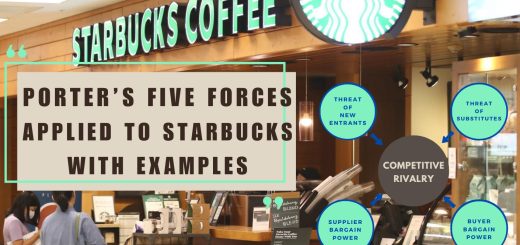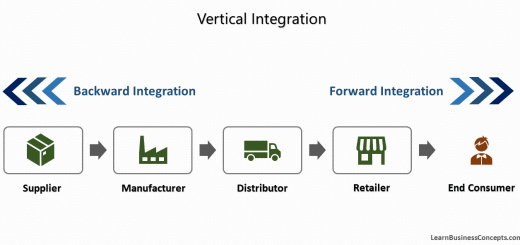Porter’s Five Forces: Applied To Clothing / Fashion Industry with Real World Examples
Porter’s Five Forces was developed by Michael Porter, a professor at Harvard Business School. The analysis is used to understand the competitive environment of an industry by examining five key factors: the threat of new entrants, bargaining power of suppliers, bargaining power of buyers, threat of substitute products, and intensity of competitive rivalry.
This analysis is useful for businesses as it provides a framework for understanding the competitive landscape of their industry. By examining each of the five forces, businesses can identify potential risks and opportunities, and develop strategies to succeed in the market.
The global clothing industry is driven by factors such as fashion trends, pricing, quality, design, brand reputation, and supply chain efficiency. Clothing companies compete to capture consumer attention, gain market share, and maintain profitability.
In the American clothing industry, competition is particularly intense due to the presence of both domestic and international brands. The United States is home to numerous well-established fashion brands, including Nike, Levi’s, Gap, Ralph Lauren, and many others. These brands compete on various fronts, such as product innovation, marketing strategies, and retail presence, to cater to diverse consumer segments and capture market share.
American clothing companies face continuous challenges to identify the changes in consumer preferences, the rise of fast fashion trends, new e-commerce-based clothing businesses, increased international competition, also the need to address sustainability and ethical concerns.
By using Porter’s Five Forces analysis, we can gain a better understanding of the competitive environment in this industry. Following is a detailed description of each force aligned with the Clothing / Fashion Industry.
1. The Threat of New Entrants
This force refers to the ease or difficulty with which new companies can enter the market. High barriers to entry, such as high capital requirements, regulatory restrictions, and economies of scale, can make it difficult for new companies to enter the market. In contrast, low barriers to entry, such as low startup costs, easy access to technology, and low regulatory restrictions, can make it easier for new companies to enter the market.
The threat of new entrants in the clothing industry is relatively high. Establishing a clothing brand requires creativity, access to manufacturing capabilities, supply chain management, distribution networks, and marketing efforts. However, the industry has relatively low entry barriers, allowing new players to enter the market. The rise of e-commerce platforms and social media has facilitated the entry of small-scale and direct-to-consumer brands, challenging established brands and disrupting traditional retail channels.
2. The Bargaining Power of Suppliers
This force refers to the power that suppliers have over the industry. Suppliers can exert power by controlling the supply of critical inputs, charging high prices, or limiting the quality of their products.
In the clothing industry, suppliers include textile manufacturers, fabric suppliers, and garment factories. The bargaining power of suppliers can vary depending on factors such as the availability of raw materials, manufacturing capacity, and uniqueness of fabrics. Clothing brands with strong relationships and long-term contracts with reliable suppliers may have more control over quality, delivery, and pricing. However, the presence of numerous suppliers worldwide provides options for clothing brands, reducing supplier power to some extent.
One of the greatest challenges in fashion retail is to secure reliable suppliers. When a clothing company builds a new alliance with a supplier, they should look for long-term association because this will enable them to work together on improving the customization and quality, while they plan for shifts in demands in advance and reduce costs by minimizing waste. However, it might be difficult to find suppliers who meet all the requirements and it is best to compare a number of them before committing to one. European and American companies mostly outsource their products, and this further complicates issues by including geographical and linguistic barriers into the mix. It is certainly difficult to communicate the exact needs of a brand to a supplier who speaks a different language and a lot might get lost in translation (Source: Supply Chain Challenges In Apparel Industry and How You Can Fix Them - By fashinza.com).
3. The Bargaining Power of Buyers
This force refers to the power that buyers have over the industry. Buyers can exert power by demanding low prices, high quality, or other favorable terms. In industries where buyers have many options or where the products are not highly differentiated, buyers have more power.
Buyer power in the clothing industry is very significant. Consumers have a wide range of choices and can easily switch between brands based on price, style, and quality. Online shopping has also given buyers more flexibility by allowing them to compare prices and reviews easily. Fast fashion brands often cater to price-sensitive consumers, while premium and luxury brands target specific customer segments with higher brand loyalty. Brand reputation, customer service, and unique offerings are some strategies that can help mitigate the power of buyers.
4. The Threat of Substitute Products or Services
This force refers to the threat of substitutes, or alternative products or services that can fulfill the same customer need. The availability of substitutes can limit the pricing power of companies in the industry, as customers can choose to switch to substitutes if prices become too high.
The clothing industry faces a moderate threat from substitute products. Substitutes include alternative clothing options such as second-hand apparel, rental services, and online marketplaces for pre-owned clothing. These alternatives cater to price-conscious consumers, sustainable fashion enthusiasts, and those seeking unique pieces. The best benefit for established clothing brands is that they can differentiate themselves through brand recognition, quality control, and exclusive designs, reducing the threat from substitutes.
5. The Intensity of Competitive Rivalry
This force refers to the intensity of competition among existing companies in the industry. The level of competition depends on factors such as the number of competitors, the level of differentiation, and the degree of price competition. High levels of competition can lead to lower prices, reduced profitability, and higher marketing costs.
The clothing industry is highly competitive, with numerous brands, both global and local, competing for market share. Competitive factors include pricing, product differentiation, brand reputation, design, quality, and marketing. Fast fashion brands often engage in intense rivalry, frequently releasing new collections and offering competitive prices. Differentiation strategies, such as unique designs, sustainable practices, and brand loyalty programs, can help brands maintain a competitive advantage.
The fashion industry is no stranger to intense competition. With the onset of online stores, shoppers have more access to a broader selection of products, ultimately making it more difficult for retailers to stand out from the crowd.
As such, fashion businesses need to have a unique edge to remain competitive. This could be in the form of superior branding or a superior product offering. By having these advantages, companies can ensure they stay ahead of the curve and continue to provide customers with the best experience possible.
(Source: Discover the current landscape of the fashion market and how to stay competitive - By audaces.com)
Key Takeaways
The fashion industry analyzed through Porter’s Five Forces framework, reveals a highly competitive landscape with distinct market dynamics. The competitive rivalry among fashion brands is intense, driven by factors such as brand reputation, product differentiation, pricing strategies, and marketing efforts. Supplier power is influenced by the availability of raw materials, manufacturing capabilities, and the importance of supplier relationships.
In the fashion industry, buyer power is relatively high due to the abundance of fashion options, consumer price sensitivity, and the ease of switching brands. The threat of new entrants is significant, given the relatively low barriers to entry, accessibility of manufacturing capabilities, and the emergence of direct-to-consumer business models. Also, the threat of substitute products is present as consumers have a wide range of alternatives to choose from, including different apparel categories, accessory options, and other forms of self-expression.
To thrive in this competitive industry, fashion companies must focus on building strong brand identities, fostering supplier relationships, understanding consumer preferences, embracing innovation, and staying agile to meet changing market demands.
Competition and Challenges of the American and Global Clothing / Fashion Industry
The global clothing or fashion industry is highly competitive, characterized by a vast number of brands, retailers, and manufacturers operating on a global scale. The industry is driven by factors such as fashion trends, pricing, quality, design, brand reputation, and supply chain efficiency. Clothing companies compete to capture consumer attention, gain market share, and maintain profitability.
In the American clothing / fashion industry, competition is particularly intense due to the presence of both domestic and international brands. The United States is home to numerous well-established fashion brands, including Nike, Levi’s, Gap, Ralph Lauren, and many others. These brands compete on various fronts, such as product innovation, marketing strategies, and retail presence, to cater to diverse consumer segments and capture market share.
The American clothing / fashion industry faces challenges, including changing consumer preferences and a highly saturated market. Consumers are increasingly seeking unique, sustainable, and value-driven fashion choices. Fast fashion brands have gained popularity, offering affordable and on-trend clothing options, which puts pressure on traditional retailers to adapt and meet consumer demands for both style and sustainability.
E-commerce has also transformed the landscape of the American clothing industry. Online retailers, such as Amazon, have disrupted the traditional retail model, providing convenient shopping experiences and competitive pricing. Brick-and-mortar stores have had to invest in their online presence and create seamless omnichannel experiences to remain competitive.
Moreover, globalization has further intensified competition in the American clothing industry. International brands, particularly those from fast-growing markets like China and South Korea, have expanded their reach into the American market, offering unique designs and competitive pricing. This influx of international competition has forced American clothing companies to differentiate themselves through brand heritage, quality craftsmanship, and innovative designs.
The industry also faces challenges related to sustainability and ethical practices. Consumers are increasingly conscious of the environmental and social impact of the fashion industry. Clothing companies need to address these concerns by adopting sustainable sourcing, production, and manufacturing practices. They must also ensure transparency in their supply chains and improve working conditions to meet the expectations of socially conscious consumers.
In summary, the fashion industry globally and in the United States is highly competitive. American clothing companies face challenges posed by changing consumer preferences, the rise of fast fashion and e-commerce, increased international competition, and the need to address sustainability and ethical concerns. To remain competitive, companies must stay attuned to evolving consumer trends, invest in technology and e-commerce capabilities, differentiate through brand positioning and sustainability efforts, and create compelling and unique fashion offerings.
Read More About Porter’s Five Forces,
- Porter’s Five Forces: Explanation with Industry Examples
- Porter’s Value Chain: Primary & Support/Secondary Activities
- Porter’s Five Forces: Advantages and Disadvantages
- How to Apply Porter’s Five Forces to Industry / Business: Step-By-Step Simple Detail Guide with Examples
- Porter’s Five Forces: Applied To Airline Industry with Real World Examples
- Porter’s Five Forces: Applied To Fast Food Restaurants Industry with Real World Examples
- Porter’s Five Forces: Applied To Starbucks with Examples
- Porter’s Five Forces: Applied To Banking Industry with Real World Examples


